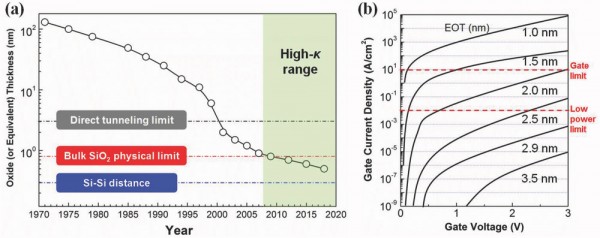Solution Processed Metal Oxide High-kappa Dielectrics for Emerging Transistors and Circuits
- 저자
- Ao Liu, Huihui Zhu, Huabin Sun, Yong Xu*, Yong-Young Noh*
- 저널명
- Advanced Materials, 30, 33, 1706364 (2018)
- 년도
- 2018
- Link
- https://doi.org/10.1002/adma.201706364 591회 연결
[Abstract]
The electronic functionalities of metal oxides comprise conductors, semiconductors, and insulators. Metal oxides have attracted great interest for construction of large-area electronics, particularly thin-film transistors (TFTs), for their high optical transparency, excellent chemical and thermal stability, and mechanical tolerance. High-permittivity (κ) oxide dielectrics are a key component for achieving low-voltage and high-performance TFTs. With the expanding integration of complementary metal oxide semiconductor transistors, the replacement of SiO2 with high-κ oxide dielectrics has become urgently required, because their provided thicker layers suppress quantum mechanical tunneling. Toward low-cost devices, tremendous efforts have been devoted to vacuum-free, solution processable fabrication, such as spin coating, spray pyrolysis, and printing techniques. This review focuses on recent progress in solution processed high-κ oxide dielectrics and their applications to emerging TFTs. First, the history, basics, theories, and leakage current mechanisms of high-κ oxide dielectrics are presented, and the underlying mechanism for mobility enhancement over conventional SiO2 is outlined. Recent achievements of solution-processed high-κ oxide materials and their applications in TFTs are summarized and traditional coating methods and emerging printing techniques are introduced. Finally, low temperature approaches, e.g., ecofriendly water-induced, self-combustion reaction, and energy-assisted post treatments, for the realization of flexible electronics and circuits are discussed.
